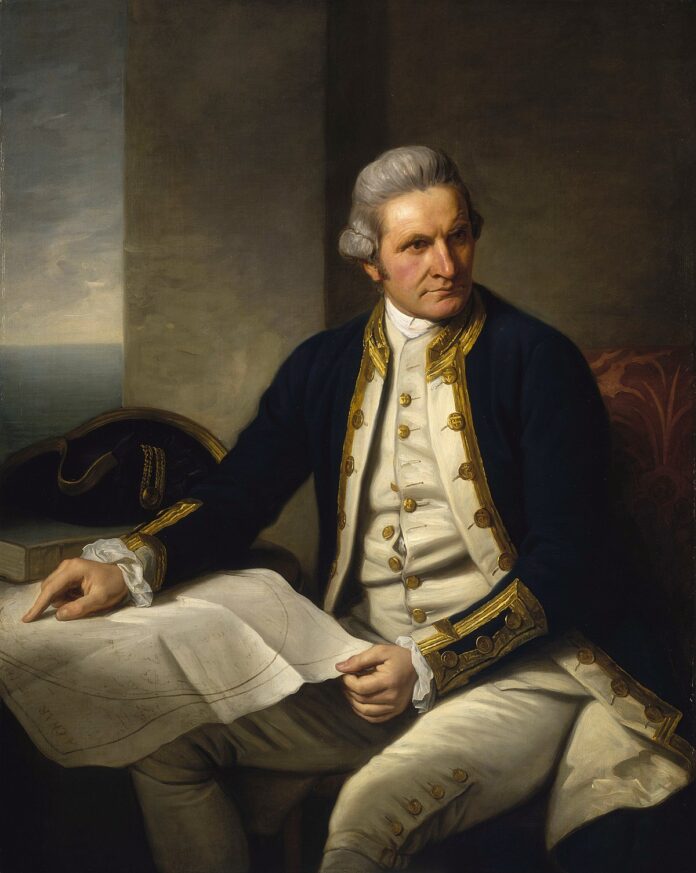The unfortunate fate of the famous navigator, James Cook, is well known. But what exactly caused his life to end so tragically? Why did a series of random events lead to Cook becoming a meal for bloodthirsty natives? Let’s delve into the details!
Brief Biography
James Cook was born in Great Britain into a modest family. He received his education at a village school. At the age of 18, he decided to work as a cabin boy on the coal-carrying ship Hercules. After 10 years of building his career in a trading company, Cook joined the royal service with considerable experience.
In 1776, the young navigator embarked on his third circumnavigation aboard the ship Resolution. One of his tasks was to explore the islands of Tahiti and New Zealand. In 1778, Cook’s ship encountered a violent storm, and the crew decided to dock at the nearest island, Kauai, part of the Hawaiian archipelago.
Meeting with the Locals
As soon as the ship anchored, the locals approached the sailors. The natives were amazed by both the British themselves and their ships. Fortunately, the British and the islanders quickly found a way to communicate, and nothing foretold the disaster. Cook even gifted one of the chiefs his personal dagger, which was highly valued by the natives for its metal. This gesture earned him the respect of the islanders, and he was even invited to one of their villages.
The crew of the Resolution stayed on the island for several months, during which time the locals provided them with food. Unfortunately, the islanders also began to steal metal parts from Cook’s ships, but the crew had to turn a blind eye to this, as retaliation could lead to a loss of provisions and even starvation.
Eventually, the sailors decided to leave the island. However, they soon had to return because the mast of one of their ships broke. The islanders were not pleased by their return.
“Taboo” on Returning
Why did Cook’s return displease the Hawaiians? Despite the relatively good relations between the sailors and the locals, the islanders were unhappy that the British had stayed on their island for so long, depleting their resources. One of the chiefs imposed a strict taboo on the return of the Resolution. However, the ship’s mast required repairs, so Cook made the fateful decision that would cost him his life.
The king of Kauai came out to meet Cook, and their negotiations went peacefully. The king agreed to let Cook’s crew stay for a short time. However, other islanders were not pleased with this agreement, even refusing to provide the crew with fresh water. It seemed that no serious conflict would arise, as the repairs would only take a few days.
But soon after, an event occurred that sparked the subsequent chain of events. During the night, a group of islanders stole one of the ship’s best boats. The sailors fired after them, attempting to stop the thieves but failed. Upon learning of this, Cook decided to outsmart the islanders.
The Failed Ultimatum
After the boat was stolen, Cook invited the king of Kauai aboard his ship, planning to hold him hostage until the stolen boat was returned. However, the king, sensing that something was wrong, refused. As a result, Cook had to go ashore to begin new negotiations.
As soon as Cook stepped onto the shore, gunfire erupted from his ship. It is unclear why the sailors fired; perhaps they thought their captain was in danger. For the islanders, however, this was a declaration of war. Several of them, armed with clubs and knives, attacked James Cook, who died from his injuries.
After learning of Cook’s death, his deputy requested the return of Cook’s body. The islanders complied, though they only returned his head, wrapped in bloody cloth, along with parts of his dismembered torso. Thus, the legend that the natives ate James Cook was born.
The Reality Behind the Legend
If not for the gunshots, Cook might have survived, and the legend of his cannibalistic demise would never have emerged. Why a legend? Because, in fact, the Hawaiians did not eat him at all. They respected Captain Cook and buried him according to local customs, separating the muscles from the bones and performing burial rites over the skeleton. What remained of Cook’s body was given back to the crew of the Resolution, fulfilling the request of the overly confident British, who had underestimated their strength in dealing with the local tribe, believing that the natives had nothing to counter their weapons.
